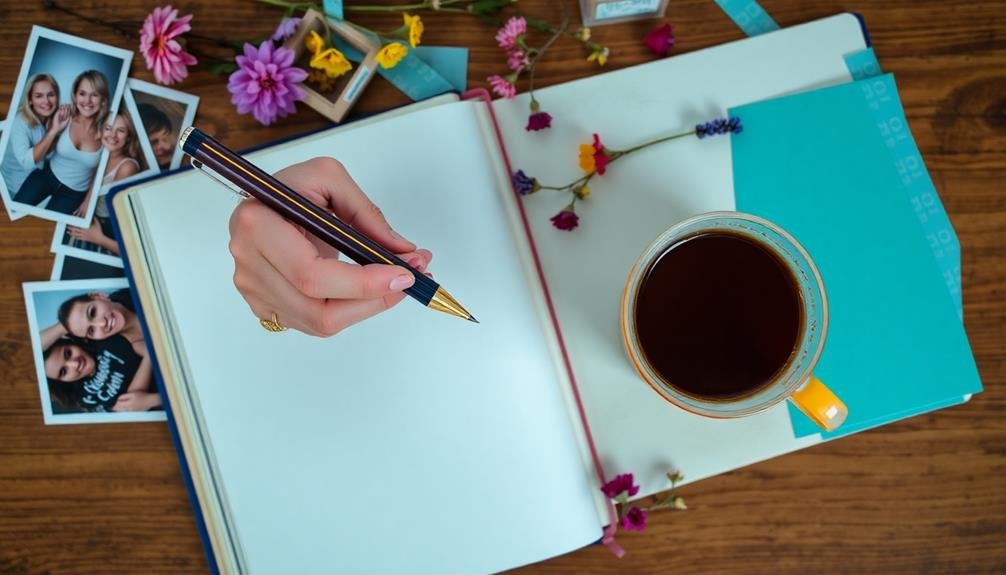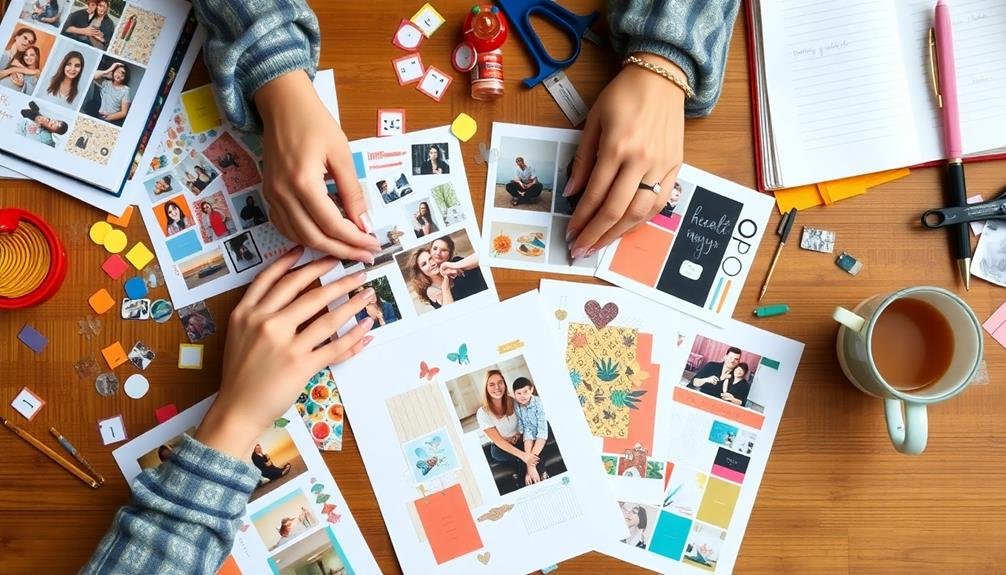If you're an anxious scrapbooker, try these three memory-keeping techniques to simplify your process and reduce overwhelm. First, practice mindful journaling with photos, capturing emotions and thoughts alongside visual memories. Second, use simplified layouts with basic grids and limited color palettes for easy completion. Third, explore digital scrapbooking, which offers mistake-free editing and space-saving solutions. These approaches can help you focus on preserving memories without getting bogged down in perfectionism. By incorporating these techniques, you'll find scrapbooking becomes a more relaxing and enjoyable experience. Discover how these methods can transform your memory-keeping journey and reignite your creativity.
Mindful Journaling Alongside Photos

Mindful journaling alongside photos is a powerful technique for scrapbookers to enhance their memory-keeping projects. It allows you to capture not just the visual aspects of a moment, but also the emotions, thoughts, and sensations associated with it.
Start by selecting a photo that evokes strong feelings or memories. As you look at the image, take a few deep breaths and focus on the details.
Write down your immediate reactions, describing what you see, hear, smell, or feel when you recall the moment. Don't worry about perfect grammar or structure; let your thoughts flow freely. Ask yourself questions like: What was happening just before or after this photo was taken? How did you feel at that time? What details do you notice that you might've forgotten?
Consider using prompts to dig deeper into your memories. For example: "This moment reminds me of…" or "I wish I could tell my future self…"
Simplified Layouts for Easy Completion
While mindful journaling adds depth to your scrapbooking, it's important to balance detailed content with manageable layouts. Simplified designs can help you complete pages more easily, reducing anxiety and maintaining momentum in your memory-keeping journey.
Start by choosing a basic grid structure for your layouts. Use 2×2, 3×3, or 4×4 grids to organize your photos and journaling blocks. This approach provides a clean, structured look and makes it easier to arrange elements quickly.
Stick to a limited color palette, perhaps using just two or three complementary colors per layout. This decision will streamline your creative process and create visual cohesion.
Consider using pre-made templates or sketches as a starting point. These can serve as a framework, allowing you to focus on your photos and memories rather than agonizing over design decisions.
Embrace white space in your layouts; it gives your eyes a place to rest and prevents overwhelming page designs.
Lastly, create a "go-to" kit with your favorite papers, embellishments, and tools. Having these essentials readily available will speed up your process and reduce decision fatigue, making scrapbooking a more enjoyable and less stressful experience.
Digital Scrapbooking for Overwhelm Relief

Feeling overwhelmed by physical supplies and clutter? Digital scrapbooking might be the perfect solution for you. This modern approach to memory-keeping allows you to create beautiful layouts without the mess of traditional supplies. You'll have access to endless digital elements, papers, and embellishments, all stored neatly on your computer or in the cloud.
To get started with digital scrapbooking, you'll need:
- A computer or tablet
- Photo editing software (like Photoshop Elements or Canva)
- Digital scrapbooking kits or elements
Digital scrapbooking offers several benefits for anxious memory-keepers. You can easily undo mistakes, resize elements, and experiment with different layouts without wasting physical materials.
It's also space-saving, as your entire collection of supplies fits on a hard drive. Plus, you can create multiple copies of your layouts for sharing or printing.
Don't worry if you're not tech-savvy. Many user-friendly apps and websites cater to beginners, offering templates and drag-and-drop interfaces.
As you become more comfortable, you can explore advanced techniques like blending and digital brushwork. Embrace the digital domain to simplify your scrapbooking process and reduce anxiety-inducing clutter.
Frequently Asked Questions
How Can I Preserve Old, Damaged Photos for Scrapbooking?
To preserve old, damaged photos for scrapbooking, you can:
- Scan them digitally
- Use archival-quality sleeves
- Apply gentle adhesives
- Create copies for use
- Store originals in acid-free containers
- Avoid direct sunlight exposure
These methods will help protect your memories.
What Are Some Eco-Friendly Alternatives to Traditional Scrapbooking Materials?
You'll find plenty of eco-friendly scrapbooking options. Try recycled paper, soy-based inks, and natural adhesives. Use digital scrapbooking to reduce waste. Repurpose old materials like fabric scraps or pressed flowers for unique, sustainable embellishments.
How Do I Organize Years of Backlogged Photos and Memorabilia?
You'll want to start by sorting your photos and memorabilia chronologically. Create a system using boxes or folders for each year. Then, digitize what you can, purge unnecessary items, and begin organizing the rest into themed albums or scrapbooks.
Are There Scrapbooking Techniques Specifically Designed for Trauma Survivors?
Yes, there are scrapbooking techniques for trauma survivors. You'll find methods like art journaling, collage-making, and memory mapping helpful. These techniques allow you to process emotions safely, create visual narratives, and reclaim your story at your own pace.
What Are Some Creative Ways to Incorporate Non-Photo Memorabilia Into Scrapbooks?
You can creatively include non-photo memorabilia in your scrapbooks by using ticket stubs, pressed flowers, or postcards. Try creating pockets for small items, or use washi tape to attach fabric swatches. Don't forget to incorporate handwritten notes or letters.
In Summary
You've now got three powerful techniques to make scrapbooking less stressful and more enjoyable. Whether you're journaling mindfully, simplifying your layouts, or going digital, remember that preserving memories doesn't have to be perfect. It's about capturing moments that matter to you. Don't let anxiety hold you back from documenting your life. Embrace these methods, and you'll find scrapbooking becomes a source of joy rather than stress. Start small, be kind to yourself, and watch your creativity flourish.





Leave a Reply